Oxford
Instruments very kindly brought their handheld XRF machine to the York so
that we could examine some of the ferrous material we had gathered.
We wanted to check the ironwork because, during the course of the project, it has gradually become clear that the iron
was being re-processed around the area. Because this has never been positively
identified around any other battle from this era, it was important to find out
as much as possible as the bits and pieces.
We could not be sure what we would find: the results have helped to confirm
the working hypothesis that this was post-battle metal-recycling. But the XRF
data has provided an insight that will take some time to understand.
What is X Ray Fluorescence?
This clever device shines xrays at the surface and records what bounces back.
(This is like shining a special torch but you would need x-ray eyes to see the
reflection).
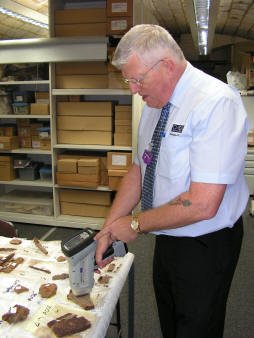 |
(Left) Richard, from
Oxford Instruments, holds the
X-MET5000 machine to measure the composition
of the axe head billet.
The machine allowed us to screen any modern material and has revealed
several interesting groups of iron and the significance of this is now being
investigated.
By revealing the composition of the iron it has provided a fresh insight
into the items collected.
|
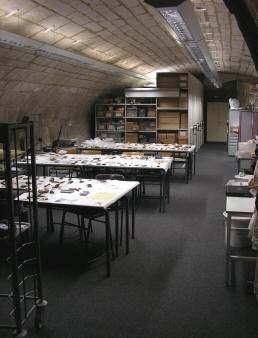 |
| (Right) Paul and Wilf from the York Metal Detectorists Club
were on hand to help layout the material. The Club worked over many seasons
to collect the material from Fulford. While the XRF work was in progress
they checked through the non-ferrous material to make sure that nothing
significant had been overlooked. |
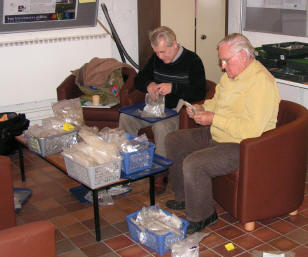 |
(Above) The laboratory at King's Manor, at the University of
York, was kindly lent to us for 5 days along with two skilful technicians.
One table was devoted to each of the hearth areas identified. Around 300
items were measured from the collection of nearly 2000 ferrous pieces
collected by the metal detectorists. |
It will take 6 months to analyse all the data produced. The key finding is
that the items tested are all pre-industrial (apart from a few test pieces that
were slipped into the mix).
But;
- The items that we think are anvils have some fascinating trace elements on
their surface.
- We are not dealing with a random scatter of metal.
- There seem to be a number of distinct types of iron - now if these can
linked to similar iron compositions from other places....
- Grouping the metal together (using the data) rather than the shapes is
getting us close to just what was going on.
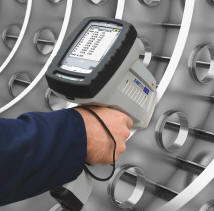 |
Some brilliant technology enabled a small
xray source which dose not require its own power station to be constructed.
Xray 'excite' the target surface which then emit a pulse.
The machine then does some very clever calculations to work
out which elements, and how much of them, are present in the sample. It can
do this because it every element has a 'fingerprint' of the radiations it
emits.
We hope to use this machine's versatile capabilities to
examine the soil from selected areas for traces of iron. |
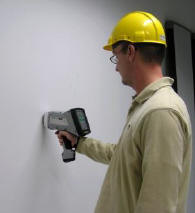 |
So:
A very big thank-you to
Oxford Instruments
for all their help (This was the second time they have helped on the Fulford
project).
And to the staff and students at the
Department of Archaeology at the
University of York for accommodating and working round us.
Without the assistance and guidance of so
many people during this project, we could not have achieved such an insight into
our past.

